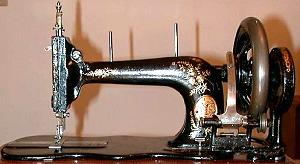The New Family and Related Models

(Picture Courtesy of Linda Heminway)
In 1865 the "New Family" was put on the market and had a large and wide distribution; more than four millions of this type were sold up to 1882 and it is still [1914] in demand in various countries of the world. The machine makes a lock-stitch by means of a straight eye-pointed needle and a longitudinally reciprocating shuttle. The needle-bar derives its motion from a pin on the end of a rotating horizontal main shaft, the pin entering a heart-shaped groove in a block attached to the needle-bar. A bevel gear on the main shaft connects with a vertical shaft provided at its lower end with a crank, connected by link with the shuttle driver or carrier. The four-motion feed-dog is operated through the horizontal lever actuated from the vertical shaft. The feed is adjusted through a movable fulcrum, controlled by a set-screw. A take-up lever controls the thread between the tension device and the eye of the needle. In 1867 a modification of the "New Family" called "No. 1 Drop Feed" was produced, and in 1870, the "Medium," an enlarged "New Family," was used extensively for light manufacturing.

(Text and Picture Courtesy of Dorothy Brumleve)
The "Medium" machine, identical with the "New Family" except that it has more room under the arm (length of arm, 12 inches), was larger and designed for stitching heavier materials. The "No. 4" machine was identical, except in size, with the "New Family" and "Medium." It had 15 inches length of overhanging arm and was made in response to the demand of clothing manufacturers for a machine for power operation.






